

Extracurricular activity. Extracurricular activities or Extra Academic Activity (EAA) are those that fall outside the realm of the normal curriculum of school or university education, performed by students.
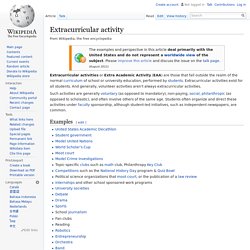
Extracurricular activities exist for all students. And generally, volunteer activities aren't always extracurricular activities. Examples[edit] See also[edit] External links[edit] The History of Extracurricular Activities The development of extracurricular activities was slow in the beginning, with many seeing it simply as a fad that would pass and quickly fade out of style (Millard, 1930, p. xi). Education Facts for Kids. From KidzSearch, the safe free Wikipedia for kids.
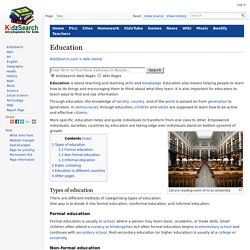
KidzSearch.com > Wiki Home Education is about teaching and learning skills and knowledge. Education also means helping people to learn how to do things and encouraging them to think about what they learn. It is also important for educators to teach ways to find and use information. Through education, the knowledge of society, country, and of the world is passed on from generation to generation. More specific, education helps and guide individuals to transform from one class to other. Types of education There are different methods of categorizing types of education. Formal education Formal education is usually in school, where a person may learn basic, academic, or trade skills.
Non-formal education Non-formal education includes adult basic education, adult literacy education or school equivalency preparation. Subject (school) Facts for Kids. From KidzSearch, the safe free Wikipedia for kids.
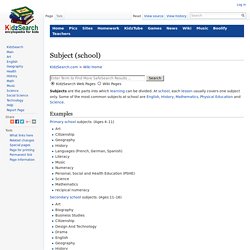
KidzSearch.com > Wiki Home Subjects are the parts into which learning can be divided. At school, each lesson usually covers one subject only. Some of the most common subjects at school are English, History, Mathematics, Physical Education and Science. Primary school subjects: (Ages 4–11) Art Citizenship Geography History Languages (French, German, Spanish) Literacy Music Numeracy Personal, Social and Health Education (PSHE) Science Mathematics recipical numeracy.
Comparison of American and British English. Linguistic comparison The English language was first introduced to the Americas by British colonization, beginning in the late 16th and early 17th centuries.
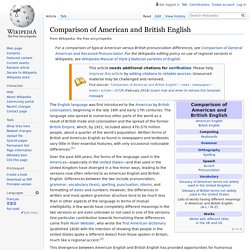
The language also spread to numerous other parts of the world as a result of British trade and colonisation and the spread of the former British Empire, which, by 1921, included about 470–570 million people, about a quarter of the world's population. Written forms of British and American English as found in newspapers and textbooks vary little in their essential features, with only occasional noticeable differences.[1] This divergence between American English and British English has provided opportunities for humorous comment: e.g. in fiction George Bernard Shaw says that the United States and United Kingdom are "two countries divided by a common language";[3] and Oscar Wilde says that "We have really everything in common with America nowadays, except, of course, the language" (The Canterville Ghost, 1888).
Vocabulary[edit] BrE: AmE: Katie : my school day. Secondary school Facts for Kids. From KidzSearch, the safe free Wikipedia for kids.
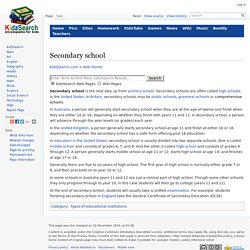
KidzSearch.com > Wiki Home Secondary school is the next step up from primary school. Secondary schools are often called high schools in the United States. Middle school Facts for Kids. From KidzSearch, the safe free Wikipedia for kids.

KidzSearch.com > Wiki Home In the United States, middle school is a school between elementary school (grades 1-4, 1-5 or 1-6) and high school (grades 9-12 or 10-12). Depending on location, middle school contains grades 6-8, 7-8, or 7-9. Middle school is also sometimes called junior high school or just junior high. The change from a one teacher-all subjects way of teaching helps create more independence for the pupil.
In general, middle school acts as a transition between the elementary school structure where most people are all treated the same and the high school structure were most people are treated as individuals. . ↑ Teachers, Schools, and Society A Brief Introduction to Education (2nd edition) Sadker, Miller David and Zittleman, R. Nl:Onderwijs in de Verenigde Staten#Middelbaar onderwijs. Primary school Facts for Kids. High school Facts for Kids. From KidzSearch, the safe free Wikipedia for kids.
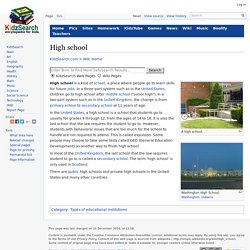
KidzSearch.com > Wiki Home High school is a kind of school, a place where people go to learn skills for future jobs. In a three-part system such as in the United States, children go to high school after middle school ("junior high"). In a two-part system such as in the United Kingdom, the change is from primary school to secondary school at 11 years of age. In the United States, a high school is a school that students go to usually for grades 9 through 12, from the ages of 14 to 18. In most of the United Kingdom, the last school that the law requires student to go to is called a secondary school. There are public high schools and private high schools in the United States and many other countries. United States Guide: The American school system, Grades, school hours and terms: Most children start school.
U.S. System of Education - English Language Notes 2.